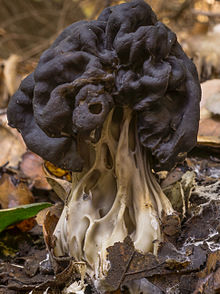
Helvella crispa, also known as the white saddle, elfin saddle or common helvel, is an ascomycete fungus of the family Helvellaceae. The mushroom is readily identified by its irregularly shaped whitish cap, fluted stem, and fuzzy undersurfaces. It is found in eastern North America and in Europe, near deciduous trees in summer and autumn.
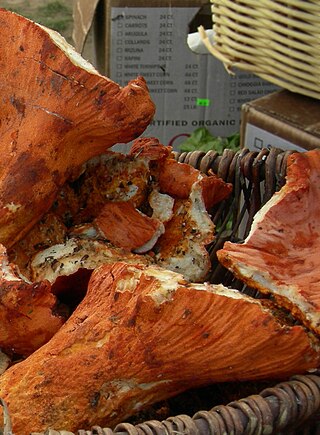
Hypomyces is a genus of parasitic ascomycete fungi found in Europe, North America, Australia, and parts of China. The genus contains 53 species. Better known species include the lobster mushroom and the bolete eater.

Gyromitra is a genus of about 18 species of ascomycete fungi. They are a false morel - a frequently toxic mushroom that can be mistaken for edible mushrooms of the genus Morchella (morels).

Gyromitra infula, commonly known as the hooded false morel or the elfin saddle, is a fungus in the family Helvellaceae. The dark reddish-brown caps of the fruit bodies develop a characteristic saddle-shape in maturity, and the ends of both saddle lobes are drawn out to sharp tips that project above the level of the fruit body. The stipe is white or flushed pale brown, smooth on the outside, but hollow with some chambers inside. It is found in the Northern Hemisphere, usually in the late summer and autumn, growing on rotting wood or on hard packed ground. G. infula is considered inedible as it contains the toxic compound gyromitrin which, when metabolized by the body, is converted into monomethylhydrazine, a component of some rocket fuels. The toxin may be removed by thorough cooking. Gyromitra fungi are included in the informal category "false morels".

Helvella is a genus of ascomycete fungus of the family Helvellaceae. The mushrooms, commonly known as elfin saddles, are identified by their irregularly shaped caps, fluted stems, and fuzzy undersurfaces. They are found in North America and in Europe. Well known species include the whitish H. crispa and the grey H. lacunosa. They have been reported to cause gastrointestinal symptoms when eaten raw.
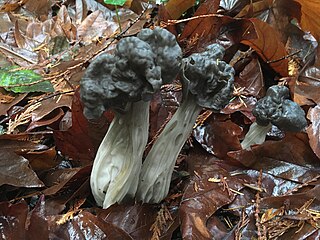
Helvella lacunosa, known as the slate grey saddle or fluted black elfin saddle in North America, simply as the elfin saddle in Britain, is an ascomycete fungus of the family Helvellaceae. It is one of the most common species in the genus Helvella. The mushroom is readily identified by its irregularly shaped grey cap, fluted stem, and fuzzy undersurfaces. It is usually found in Eastern North America and in Europe, near deciduous and coniferous trees in summer and autumn.

Helvella acetabulum is a species of fungus in the family Helvellaceae, order Pezizales. This relatively large cup-shaped fungus is characterized by a tan fruit body with prominent branching ribs resembling a cabbage leaf; for this reason it is commonly known as the cabbage leaf Helvella. Other colloquial names include the vinegar cup and the brown ribbed elfin cup. The fruit bodies reaches dimensions of 8 cm (3.1 in) by 4 cm (1.6 in) tall. It is found in Asia, Europe, and North America, where it grows in sandy soils, under both coniferous and deciduous trees.
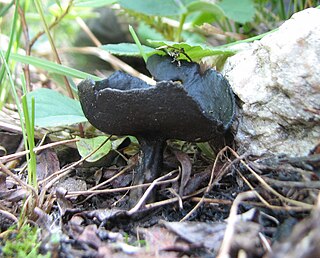
Helvella corium is a species of fungus in the family Helvellaceae of the order Pezizales. This inedible cup-shaped fungus is black, and grows on the ground often near willows in deciduous or mixed forests. Although it has a fairly wide distribution, it is uncommon.
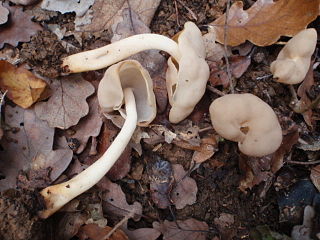
Helvella elastica, commonly known as the flexible Helvella, or the elastic saddle, is a species of fungi in the family Helvellaceae of the order Pezizales. It is found in Asia, Europe, and North America. It has a roughly saddle-shaped yellow-brown cap atop a whitish stipe, and grows on soil in woods. Another colloquial name is the brown elfin saddle.

Helvella leucomelaena, commonly known as the white-footed elf cup, is a species of fungi in the family Helvellaceae of the order Pezizales. As its common name implies, it is characterized by the white coloring of its stem.

Helvella solitaria is a species of fungus in the family Helvellaceae. Originally described as Peziza solitaria by Petter Karsten in 1869, he transferred it to the genus Helvella in 1871. The fungus has a boreal and temperate distribution.

Helvella macropus is a species of fungus in the family Helvellaceae of the order Pezizales. Ascocarps are found in summer and autumn in woodland, usually associated with broad-leaved trees. The slender stem, up to 5 centimeters high, supports a cup shaped cap, the whole fruiting body being pale grey or brown, the inner (hymenial) surface of the cup usually being darker. It is inedible.
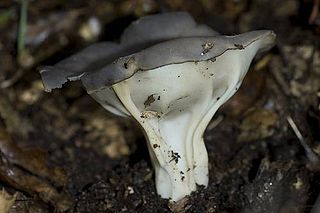
Helvella costifera is a species of fungus in the family Helvellaceae, Pezizales order. Its ascocarp has conspicuous ribs on its undersurface.

Plectania nannfeldtii, commonly known as Nannfeldt's Plectania, the black felt cup, or the black snowbank cup fungus, is a species of fungus in the family Sarcosomataceae. The fruit bodies of this species resemble small, black, goblet-shaped shallow cups up to 3 cm wide, with stems up to 4 cm long attached to black mycelia. Fruit bodies, which may appear alone or in groups on the ground in conifer duff, are usually attached to buried woody debris, and are commonly associated with melting snow. Plectania nannfeldtii is found in western North America and in Asia, often at higher elevations. Similar black cup fungi with which P. nannfeldtii may be confused include Pseudoplectania vogesiaca, P. nigrella, and Helvella corium.

Leotia lubrica, commonly referred to as a jelly baby, is a species of fungus in the family Leotiaceae. The species produces small fruit bodies up to 6 centimetres (2.4 in) in height, featuring a "head" and a stalk. Ochre with tints of olive-green, the heads are irregularly shaped, while the stalk, of a similar colour, attaches them to the ground. The appearance can be somewhat variable and is similar to a number of other species, including Cudonia confusa, C. circinans, L. atrovirens and L. viscosa. L. lubrica was first validly described by Giovanni Antonio Scopoli, but it was later transferred to Leotia by Christiaan Hendrik Persoon. Its relationship with other members of the genus, of which it is the type species, is complicated.

Helvella vespertina is a species of fungus in the family Helvellaceae. It is found in Western North America under conifers. Some specimens have a white moldy appearance, having been colonised by the parasitic Ascomycete fungus Hypomyces cervinigenus.

Hypomyces cervinigenus is a parasitic ascomycete fungus that grows on elfin saddle (Helvella) mushrooms in Europe and North America. It was described as new to science in 1971 by Clark Rogerson and Horace Simms. The type collection was made in Pierce County, Washington, where the fungus was found growing on the stipe and cap of what they identified as a fruit body of Helvella lacunosa; later molecular work demonstrated that the European H. lacunosa is not found in North America, and that the North American versions are in fact two similar species, H. vespertina and H. dryophila. H. cervinigenus has perithecia that are white to pale buff with a waxy texture. The ascospores are two-celled, smooth-walled, and measure less than 25 µm long. The anamorph form of the fungus is known as Mycogone cervina.

Helvella albella is a species of fungi in the family Helvellaceae that is found in Europe and North America. It was described by French mycologist Lucien Quélet in 1896.
Helvella semiobruta is a species of fungus in the family Helvellaceae. Originally found in the country of France, it was described as new to science in 1976. It has also been collected in Greece, and Cyprus, where it grows in maquis shrubland.
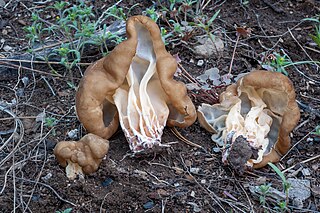
Gyromitra californica is a species of fungus in the family Discinaceae. It was described as Helvella californica by W. Phillips in 1879. It is considered probably poisonous.
